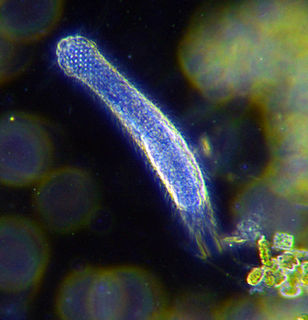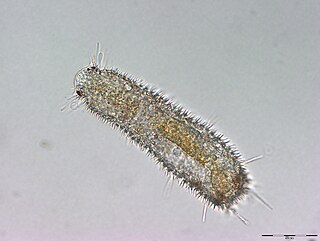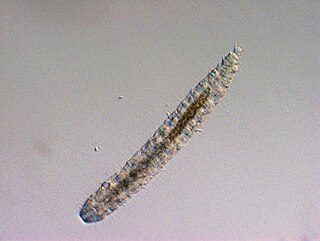
The gastrotrichs, commonly referred to as hairybellies or hairybacks, are a group of microscopic (0.06-3.0 mm), worm-like, pseudocoelomate animals, and are widely distributed and abundant in freshwater and marine environments. They are mostly benthic and live within the periphyton, the layer of tiny organisms and detritus that is found on the seabed and the beds of other water bodies. The majority live on and between particles of sediment or on other submerged surfaces, but a few species are terrestrial and live on land in the film of water surrounding grains of soil. Gastrotrichs are divided into two orders, the Macrodasyida which are marine, and the Chaetonotida, some of which are marine and some freshwater. Nearly 800 species of gastrotrich have been described.

Karl Hermann Johannes Thiele was a German zoologist specialized in malacology. Thiele was born in Goldap, East Prussia. His Handbuch der systematischen Weichtierkunde is a standard work. From 1904 until his retirement in 1925 he was the curator of the malacological collection at the Museum für Naturkunde in Berlin. Thiele described more than 1.500 new species of molluscs; until today their types are deposited with the Museum of Natural History in Berlin. Especially important are his works on the Mollusca of the First German Antarctica Expedition and of the German Deep Sea Expedition aboard the vessel Valdivia.

Macrodasyida is an order of gastrotrichs. Members of this order are somewhat worm-like in form, and not more than 1 to 1.5 mm in length.

Chaetonotidae is a family of gastrotrichs in the order Chaetonotida. It is the largest family of gastrotrichs with almost 400 species, some of which are marine and some freshwater. Current classification is largely based on shape and external structures but these are highly variable. Molecular studies show a high level of support for a clade containing Dasydytidae nested within Chaetonotidae.

Cyclorhagida is an class of kinorhynchs, which are small marine invertebrates.

Diuronotus aspetos is a species of large sized meiofaunal chaetonotid gastrotrich found in the North Atlantic. With Diuronotus rupperti, it is one of the only two species representing the genus Diuronotus.

Thaumastoderma heideri belongs to the phylum Gastrotricha and the order Macrodasyida, which are worm shaped, mainly marine species of meiofauna. They live in coarser sand and like the rest of the gastrotrichs their movement is very slow. The family Thaumastodermatidae includes more than 130 species and it can be found widely across the globe.

Macrodasys caudatus is a species of microscopic worm-like metazoan in the family Macrodasyidae in the phylum Gastrotricha. It lives in the interstices between particles of sediment on the seabed in shallow water. It is found in the Indian Ocean, the northeastern Atlantic Ocean, the Mediterranean Sea and the North Sea.

Paradasys subterraneus is a Gastrotricha with a bodylength up to 0.6 mm. The species is marine.

Lepidodermella squamata is a freshwater species of minute worm in the phylum Gastrotricha.

Joachim Steetz was a German botanist. His herbarium, comprising more than 5000 specimens from over 160 collectors and 30 countries was purchased in 1863 by Victorian Government Botanist Ferdinand von Mueller for the sum of 80 pounds. The collection is currently housed at the National Herbarium of Victoria. The herbarium was compiled by Steetz over more than thirty years and comprises 160 collectors from more than 30 countries, including type specimens from plant collectors of the time including:

Anna Maurizio was a Swiss biologist who studied bees. She worked for more than three decades in the Department of Bees at the Liebefeld Federal Dairy Industry and Bacteriological Institute, where she developed new methods for determining the amount of pollen in honey.
Neodasys is a genus of gastrotrichs in the class Chaetonotida. It is the only genus in the family Neodasyidae, which is the only family in the suborder Multitubulatina.
Dasydytidae is a family of gastrotrichs in the order Chaetonotida.
Heterolepidoderma is a genus of gastrotrichs belonging to the family Chaetonotidae.
Polymerurus is a genus of gastrotrichs belonging to the family Chaetonotidae.

Thaumastodermatidae is a family of worms belonging to the order Macrodasyida.
Mesodasys is a genus of gastrotrichs belonging to the family Cephalodasyidae.
Tetranchyroderma is a genus of gastrotrichs belonging to the family Thaumastodermatidae.

Macrodasys is a genus of gastrotrichs belonging to the family Macrodasyidae.











